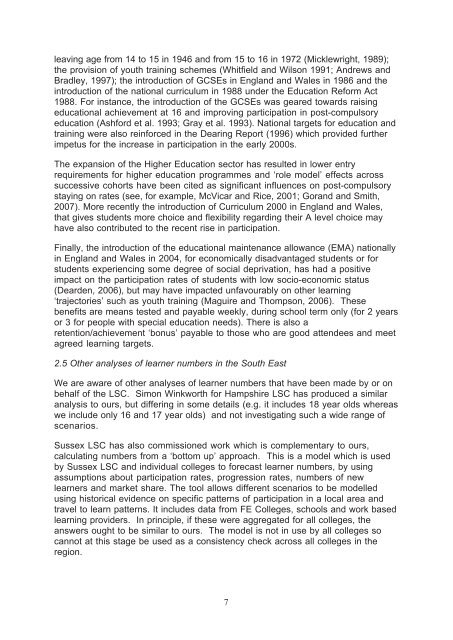LSC South East - lsc.gov.uk - Learning and Skills Council
LSC South East - lsc.gov.uk - Learning and Skills Council
LSC South East - lsc.gov.uk - Learning and Skills Council
You also want an ePaper? Increase the reach of your titles
YUMPU automatically turns print PDFs into web optimized ePapers that Google loves.
leaving age from 14 to 15 in 1946 <strong>and</strong> from 15 to 16 in 1972 (Micklewright, 1989);<br />
the provision of youth training schemes (Whitfield <strong>and</strong> Wilson 1991; Andrews <strong>and</strong><br />
Bradley, 1997); the introduction of GCSEs in Engl<strong>and</strong> <strong>and</strong> Wales in 1986 <strong>and</strong> the<br />
introduction of the national curriculum in 1988 under the Education Reform Act<br />
1988. For instance, the introduction of the GCSEs was geared towards raising<br />
educational achievement at 16 <strong>and</strong> improving participation in post-compulsory<br />
education (Ashford et al. 1993; Gray et al. 1993). National targets for education <strong>and</strong><br />
training were also reinforced in the Dearing Report (1996) which provided further<br />
impetus for the increase in participation in the early 2000s.<br />
The expansion of the Higher Education sector has resulted in lower entry<br />
requirements for higher education programmes <strong>and</strong> ‘role model’ effects across<br />
successive cohorts have been cited as significant influences on post-compulsory<br />
staying on rates (see, for example, McVicar <strong>and</strong> Rice, 2001; Gor<strong>and</strong> <strong>and</strong> Smith,<br />
2007). More recently the introduction of Curriculum 2000 in Engl<strong>and</strong> <strong>and</strong> Wales,<br />
that gives students more choice <strong>and</strong> flexibility regarding their A level choice may<br />
have also contributed to the recent rise in participation.<br />
Finally, the introduction of the educational maintenance allowance (EMA) nationally<br />
in Engl<strong>and</strong> <strong>and</strong> Wales in 2004, for economically disadvantaged students or for<br />
students experiencing some degree of social deprivation, has had a positive<br />
impact on the participation rates of students with low socio-economic status<br />
(Dearden, 2006), but may have impacted unfavourably on other learning<br />
‘trajectories’ such as youth training (Maguire <strong>and</strong> Thompson, 2006). These<br />
benefits are means tested <strong>and</strong> payable weekly, during school term only (for 2 years<br />
or 3 for people with special education needs). There is also a<br />
retention/achievement ‘bonus’ payable to those who are good attendees <strong>and</strong> meet<br />
agreed learning targets.<br />
2.5 Other analyses of learner numbers in the <strong>South</strong> <strong>East</strong><br />
We are aware of other analyses of learner numbers that have been made by or on<br />
behalf of the <strong>LSC</strong>. Simon Winkworth for Hampshire <strong>LSC</strong> has produced a similar<br />
analysis to ours, but differing in some details (e.g. it includes 18 year olds whereas<br />
we include only 16 <strong>and</strong> 17 year olds) <strong>and</strong> not investigating such a wide range of<br />
scenarios.<br />
Sussex <strong>LSC</strong> has also commissioned work which is complementary to ours,<br />
calculating numbers from a ‘bottom up’ approach. This is a model which is used<br />
by Sussex <strong>LSC</strong> <strong>and</strong> individual colleges to forecast learner numbers, by using<br />
assumptions about participation rates, progression rates, numbers of new<br />
learners <strong>and</strong> market share. The tool allows different scenarios to be modelled<br />
using historical evidence on specific patterns of participation in a local area <strong>and</strong><br />
travel to learn patterns. It includes data from FE Colleges, schools <strong>and</strong> work based<br />
learning providers. In principle, if these were aggregated for all colleges, the<br />
answers ought to be similar to ours. The model is not in use by all colleges so<br />
cannot at this stage be used as a consistency check across all colleges in the<br />
region.<br />
7
















